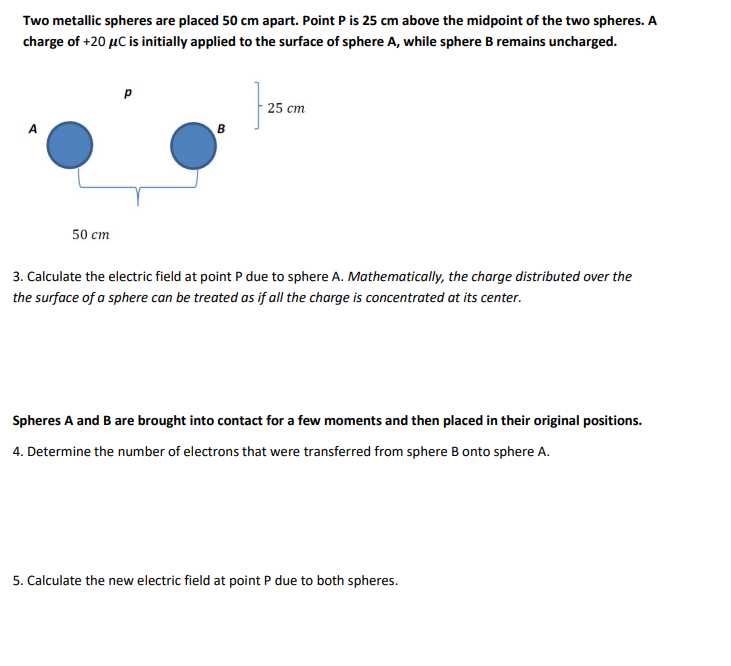Two metallic spheres are placed 50 cm apart. Point P is 25 cm above the midpoint of the two spheres. A charge of +20 μC is initially applied to the surface of sphere A, while sphere B remains uncharged. A 50 cm B 25 cm 3. Calculate the electric field at point P due to sphere A. Mathematically, the charge distributed over the the surface of a sphere can be treated as if all the charge is concentrated at its center. Spheres A and B are brought into contact for a few moments and then placed in their original positions. 4. Determine the number of electrons that were transferred from sphere B onto sphere A. 5. Calculate the new electric field at point P due to both spheres.
Two metallic spheres are placed 50 cm apart. Point P is 25 cm above the midpoint of the two spheres. A charge of +20 μC is initially applied to the surface of sphere A, while sphere B remains uncharged. A 50 cm B 25 cm 3. Calculate the electric field at point P due to sphere A. Mathematically, the charge distributed over the the surface of a sphere can be treated as if all the charge is concentrated at its center. Spheres A and B are brought into contact for a few moments and then placed in their original positions. 4. Determine the number of electrons that were transferred from sphere B onto sphere A. 5. Calculate the new electric field at point P due to both spheres.
Principles of Physics: A Calculus-Based Text
5th Edition
ISBN:9781133104261
Author:Raymond A. Serway, John W. Jewett
Publisher:Raymond A. Serway, John W. Jewett
Chapter19: Electric Forces And Electric Fields
Section: Chapter Questions
Problem 9OQ: Two solid spheres, both of radius 5 cm, carry identical total charges of 2 C. Sphere A is a good...
Related questions
Question
For questions 3 and 5 PLEASE include BOTH the ANGLE AND N/C/
Please and Thank you.

Transcribed Image Text:Two metallic spheres are placed 50 cm apart. Point P is 25 cm above the midpoint of the two spheres. A
charge of +20 μC is initially applied to the surface of sphere A, while sphere B remains uncharged.
A
50 cm
B
25 cm
3. Calculate the electric field at point P due to sphere A. Mathematically, the charge distributed over the
the surface of a sphere can be treated as if all the charge is concentrated at its center.
Spheres A and B are brought into contact for a few moments and then placed in their original positions.
4. Determine the number of electrons that were transferred from sphere B onto sphere A.
5. Calculate the new electric field at point P due to both spheres.
Expert Solution
This question has been solved!
Explore an expertly crafted, step-by-step solution for a thorough understanding of key concepts.
Step by step
Solved in 6 steps with 2 images

Follow-up Questions
Read through expert solutions to related follow-up questions below.
Follow-up Question
For the question 3 and 5 I had ask for the angles as well with the N/C.
Solution
Knowledge Booster
Learn more about
Need a deep-dive on the concept behind this application? Look no further. Learn more about this topic, physics and related others by exploring similar questions and additional content below.Recommended textbooks for you

Principles of Physics: A Calculus-Based Text
Physics
ISBN:
9781133104261
Author:
Raymond A. Serway, John W. Jewett
Publisher:
Cengage Learning

Physics for Scientists and Engineers with Modern …
Physics
ISBN:
9781337553292
Author:
Raymond A. Serway, John W. Jewett
Publisher:
Cengage Learning

Physics for Scientists and Engineers
Physics
ISBN:
9781337553278
Author:
Raymond A. Serway, John W. Jewett
Publisher:
Cengage Learning

Principles of Physics: A Calculus-Based Text
Physics
ISBN:
9781133104261
Author:
Raymond A. Serway, John W. Jewett
Publisher:
Cengage Learning

Physics for Scientists and Engineers with Modern …
Physics
ISBN:
9781337553292
Author:
Raymond A. Serway, John W. Jewett
Publisher:
Cengage Learning

Physics for Scientists and Engineers
Physics
ISBN:
9781337553278
Author:
Raymond A. Serway, John W. Jewett
Publisher:
Cengage Learning

Physics for Scientists and Engineers, Technology …
Physics
ISBN:
9781305116399
Author:
Raymond A. Serway, John W. Jewett
Publisher:
Cengage Learning

College Physics
Physics
ISBN:
9781285737027
Author:
Raymond A. Serway, Chris Vuille
Publisher:
Cengage Learning

College Physics
Physics
ISBN:
9781305952300
Author:
Raymond A. Serway, Chris Vuille
Publisher:
Cengage Learning